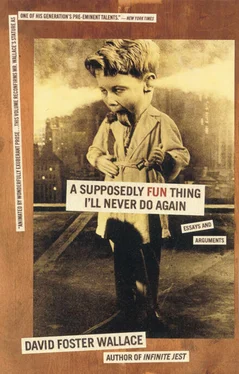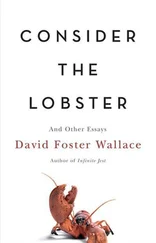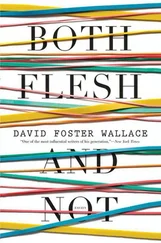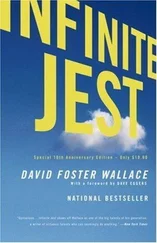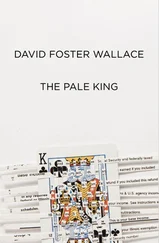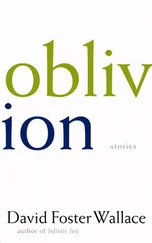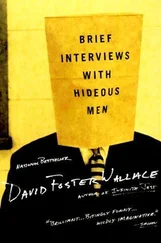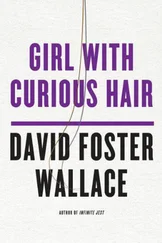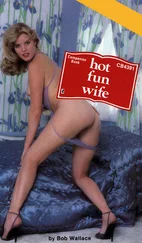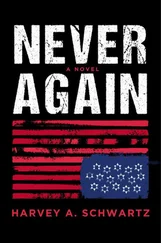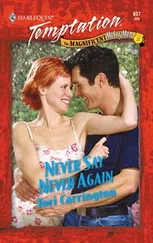Joyce’s response to this line of inquiry strikes me as both unsatisfactory and marvelous. Because of course the question is unanswerable, at least it’s unanswerable by a person who’s already — as far as he understands it— “chosen ” Joyce’s answer is that it doesn’t really matter much to him whether he originally “chose ” serious tennis or not; all he knows is that he loves it. He tries to explain his feelings at the Nationals in 1991: “You get there and look at the draw, it’s a 128 draw, there’s so many guys you have to beat. And then it’s all over and you’ve won, you’re the National Champion — there’s nothing like it. I get chills even talking about it.” Or how it was just the previous week in Washington: “I’m playing Agassi, and it’s great tennis, and there’s like thousands of fans going nuts. I can’t describe the feeling. Where else could I get that?”
What he says aloud is understandable, but it’s not the marvelous part. The marvelous part is the way Joyce’s face looks when he talks about what tennis means to him. He loves it; you can see this in his face when he talks about it: his eyes normally have a kind of Asiatic cast because of the slight epicanthic fold common to ethnic Irishmen, but when he speaks of tennis and his career the eyes get round and the pupils dilate and the look in them is one of love. The love is not the love one feels for a job or a lover or any of the loci of intensity that most of us choose to say we love. It’s the sort of love you see in the eyes of really old people who’ve been happily married for an incredibly long time, or in religious people who are so religious they’ve devoted their lives to religious stuff: it’s the sort of love whose measure is what it has cost, what one’s given up for it. Whether there’s “choice ” involved is, at a certain point, of no interest… since it’s the very surrender of choice and self that informs the love in the first place.
25(aka serve-and-volley; see Note 22)
26I don’t know whether you know this, but Connors had one of the most eccentric games in the history of tennis — he was an aggressive “power” player who rarely came to net, had the serve of an ectomorphic girl, and hit everything totally spinless and flat (which is inadvisable on groundstrokes because the absence of spin makes the ball so hard to control). His game was all the stranger because the racquet he generated all his firepower from the baseline with was a Wilson T2000, a weird steel thing that’s one of the single shittiest tennis racquets ever made and is regarded by most serious players as useful only for home defense or prying large rocks out of your backyard or something. Connors was addicted to this racquet and kept using it even after Wilson stopped making it, forfeiting millions in potential endorsement money by doing so. Connors was eccentric (and kind of repulsive) in lots of other ways, too, none of which are germane to this article.
27In the yore days before wide-body ceramic racquets and scientific strength-training, the only two venues for hitting winners used to be the volley — where your decreased distance from the net allowed for greatly increased angle (get that protractor out) — and the defensive passing shot… i.e., in the tactical language of boxing, “punch” v. “counterpunch.” The new power-baseline game allows a player, in effect, to punch his opponent all the way from his stool in the corner; it changes absolutely everything, and the analytic geometry of these changes would look like the worst calculus final you ever had in your life.
28This is why the phenomenon of “breaking serve” in a set is so much less important when a match involves power-baseliners. It is one reason why so many older players and fans no longer like to watch pro tennis as much: the structural tactics of the game are now wholly different from when they played.
29© Wichita KS’s Koch Materials Company, “A Leader in Asphalt-Emulsions Technology.”
30John McEnroe wasn’t all that tall, and he was arguably the best serve-and-volley man of all time, but then McEnroe was an exception to pretty much every predictive norm there was. At his peak (say 1980 to 1984), he was the greatest tennis player who ever lived — the most talented, the most beautiful, the most tormented: a genius. For me, watching McEnroe don a polyester blazer and do stiff lame truistic color commentary for TV is like watching Faulkner do a Gap ad.
31One answer to why public interest in mens tennis has been on the wane in recent years is an essential and unpretty thuggishness about the power-baseline style that’s come to dominate the Tour. Watch Agassi closely sometime — for so small a man and so great a player, he’s amazingly devoid of finesse, with movements that look more like a Heavy Metal musician’s than an athlete’s.
The power-baseline game itself has been compared to Metal or Grunge. But what a top P.B.er really resembles is film of the old Soviet Union putting down a rebellion. It’s awesome, but brutally so, with a grinding, faceless quality about its power that renders that power curiously dull and empty.
32(compare Ivanisevic’s at 130 mph or Sampras’s at 125, or even this Brakus kid’s at 118).
33The loop in a pro’s backswing is kind of the trademark flourish of excellence and consciousness of same, not unlike the five-star chef’s quick kiss of his own fingertips as he presents a pièce or the magician’s hand making a French curl in the air as he directs our attention to his vanished assistant.
34All serious players have these little extraneous tics, stylistic fingerprints, and the pros even more so because of years of repetition and ingraining. Pros’ tics have always been fun to note and chart, even just e.g. on the serve. Watch the way Sampras’s lead foot rises from the heel on his toss, as if his left foot’s toes got suddenly hot. The odd Tourettic way Gerulaitis used to whip his head from side to side while bouncing the ball before his toss, as if he were having a small seizure. McEnroe’s weird splayed stiff-armed service stance, both feet parallel to the baseline and his side so severely to the net that he looked like a figure on an Egyptian frieze. The odd sudden shrug Lendl gives before releasing his toss. The way Agassi shifts his weight several times from foot to foot as he prepares for the toss like he needs desperately to pee. Or, here at the Canadian Open, the way the young star Thomas Enqvist’s body bends queerly back as he tosses, limboing back away from the toss, as if for a moment the ball smelled very bad — this tic derives from Enqvist’s predecessor Edberg’s own weird spinal arch and twist on the toss. Edberg also has this strange sudden way of switching his hold on the racquet in mid-toss, changing from an Eastern forehand to an extreme backhand grip, as if the racquet were a skillet.
35Who looks rather like a Hispanic Dustin Hoffman and is an almost unbelievably nice guy, with the sort of inward self-sufficiency of truly great teachers and coaches everywhere, the Zen-like blend of focus and calm developed by people who have to spend enormous amounts of time sitting in one place watching closely while somebody else does something. Sam gets 10 % of Joyce’s gross revenues and spends his downtime reading dense tomes on Mayan architecture and is one of the coolest people I’ve ever met either inside the tennis world or outside it (so cool I’m kind of scared of him and haven’t called him once since the assignment ended, if that makes sense). In return for his 10 %, Sam travels with Joyce, rooms with him, coaches him, supervises his training, analyzes his matches, and attends him in practice, even to the extent of picking up errant balls so that Joyce doesn’t have to spend any of his tightly organized practice time picking up errant balls. The stress and weird loneliness of pro tennis — where everybody’s in the same community, sees each other every week, but is constantly on the diasporic move, and is each other’s rival, with enormous amounts of money at stake and life essentially a montage of airports and bland hotels and non-home-cooked food and nagging injuries and staggering long-distance bills, and people’s families back home tending to be wackos, since only wackos will make the financial and temporal sacrifices necessary to let their offspring become good enough at something to turn pro at it — all this means that most players lean heavily on their coaches for emotional support and friendship as well as technical counsel. Sam’s role with Joyce looks to me to approximate what in the latter century was called that of “companion,” one of those older ladies who traveled with nubile women when they went abroad, etc.
Читать дальше
